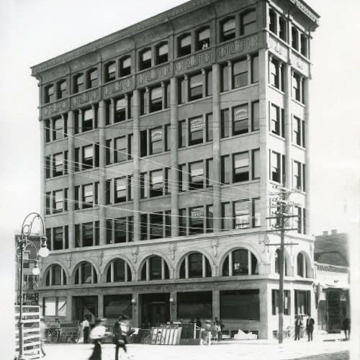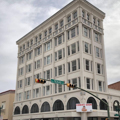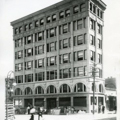The second of Henry Trost’s reinforced concrete buildings (the first was the 1909 Richard Caples Building at 300 E. San Antonio Avenue), this bank is significant for its cast-in-place concrete ornament. The seven-story slab is composed in the three-part base-shaft-attic scheme Trost used on all of the firm’s early high-rises, following the precedent of Louis Sullivan. The unusual parallelogram site places the building’s narrowest edge on Texas Avenue, giving the slender, wedge-shaped block an exaggerated sense of height. The tall ground floor (with an internal mezzanine) is faced with six arched bays on N. Mesa and two on the E. Texas Avenue side, with two additional arches connecting a low wing added a year later facing Texas. The four-story shaft has emphatic vertical piers with recessed spandrels and Chicago windows. A spandrel between the sixth- and seventh-floor windows separates the shaft from the attic story and is the only ornamented surface, a repeating composition of foliate shields in high relief, all cast in the concrete. Established in 1905, the Rio Grande Valley Bank previously occupied the Buckler Building (1907, 1913, Trost and Trost) at 203–207 N. Mesa. The building was acquired by businessman Sam Abdou in 1925.
Trost and Trost also designed the five-story office building (1910) at 215 N. Mesa for cattlemen Martin D. Roberts and William M. Banner of New Mexico. The facade has advancing end pavilions and deep-set windows, and the stringcourses and the spandrels with stylized foliate ornament emphasize the horizontal, rather than the vertical.














